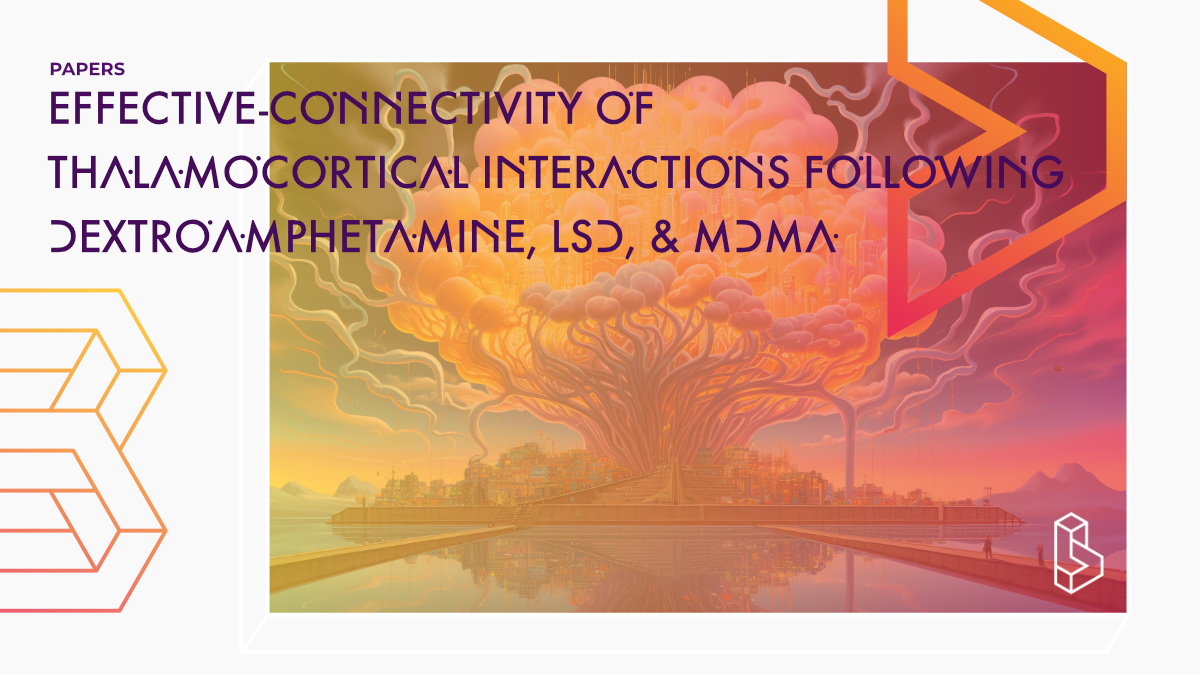This re-analysis of a double-blind, placebo-controlled, crossover study (n=25) investigated the effects of LSD, MDMA and dextroamphetamine on brain measures (thalamocortical and corticothalamic interactions in resting-state fMRI data). Compared to placebo, all three substances increased the effective-connectivity from the thalamus to specific unimodal cortices while reducing their influence on the thalamus, revealing increased bottom-up and decreased top-down information flow; LSD uniquely increased effective-connectivity to both unimodal and transmodal cortices.
Abstract of Effective-connectivity of thalamocortical interactions following dextroamphetamine, LSD, & MDMA
“Background While the exploration of serotonergic psychedelics as psychiatric medicines deepens, so does the pressure to better understand how these compounds act on the brain.
Methods We used a double-blind, placebo-controlled, crossover design and administered lysergic acid diethylamide (LSD), 3,4-methylenedioxymethamphetamine (MDMA), and d-amphetamine in 25 healthy participants. By employing spectral dynamic causal modeling, we mapped substance-induced changes in effective-connectivity between the thalamus and different cortex types (unimodal vs. transmodal) derived from a previous study in resting-state functional magnetic resonance imaging (fMRI) data. Due to the distinct pharmacological modes of action of the three substances, we were able to investigate specific effects mainly driven by different neurotransmitter systems on thalamocortical and corticothalamic interactions.
Results Compared to placebo, all three substances increased the effective-connectivity from the thalamus to specific unimodal cortices, whereas the influence of these cortices on the thalamus was reduced. These results indicate increased bottom-up and decreased top-down information flow between the thalamus and some unimodal cortices. However, for the amphetamines, we found the opposite effects when examining the effective-connectivity with transmodal cortices, covering parts of the salience network. Intriguingly, LSD increased the effective-connectivity from the thalamus to both unimodal and transmodal cortices, indicating a breach in the hierarchical organization of ongoing brain activity.
Conclusion Results advance our knowledge concerning the action of psychedelics on the brain and refine current models aiming to explain the underlying neurobiological processes.”
Authors: Mihai Avram, Felix Müller, Katrin H. Preller, Adeel Razi, Helena Rogg, Alexandra Korda, Friederike Holze, Patrick Vizeli, Laura Ley, Matthias E. Liechti & Stefan Borgwardt
Summary of Effective-connectivity of thalamocortical interactions following dextroamphetamine, LSD, & MDMA
A renewed interest in psychedelics builds on the apparent efficacy these compounds have in relieving symptoms of distinct psychiatric disorders, including depression, anxiety, and addiction. However, the mechanism(s) through which therapeutic efficacy is elicited remains elusive. The disrupted thalamic filter model (TFM) hypothesizes that changes in some aspects of neurotransmission can potentially lead to disruptions of the thalamic filter function, resulting in cortical flooding, which is thought to underlie altered mental phenomena.
Studies have shown that psychedelics increase thalamocortical intrinsic functional connectivity, which is consistent with the prediction that disrupted thalamic filtering would be accompanied by an increase in thalamic activity and influence on the cortex. Psychedelics induce thalamocortical dysconnectivity, but other substances (affecting neurotransmitters known to modulate CSTC-38 circuitry) generate similar phenomena. However, it remains unclear whether substance-induced thalamocortical dysconnectivity is driven by the thalamus, or the cortex, and are different types of cortex relevant?
Find this paper
https://doi.org/10.1016/j.bpsc.2023.07.010
Open Access | Google Scholar | Backup | 🕊
Cite this paper (APA)
Avram, M., Müller, F., Preller, K. H., Ley, L., Liechti, M. E., & Borgwardt, S. (2023). Effective-connectivity of thalamocortical interactions following d-amphetamine, LSD, and MDMA administration. Biological Psychiatry. Advance online publication. https://doi.org/10.1016/j.bpsc.2023.07.010
Study details
Topics studied
Neuroscience
Study characteristics
Original Re-analysis
Placebo-Controlled
Active Placebo
Double-Blind
Participants
25
Humans
Compound Details
The psychedelics given at which dose and how many times
LSD 100 μg | 1x MDMA 125 mg | 1xLinked Research Papers
Notable research papers that build on or are influenced by this paper
Large-scale brain connectivity changes following the administration of lysergic acid diethylamide, d-amphetamine, and 3,4-methylenedioxyamphetamineThis double-blind, placebo-controlled, crossover trial (n=28) finds that LSD (100μg), d-amphetamine (40mg), and MDMA (125mg) reduced network integrity in healthy volunteers. LSD uniquely reduced default-mode network integrity and showed more pronounced effects on network segregation and seed-based connectivity compared to amphetamines.
Distinct acute effects of LSD, MDMA, and D-amphetamine in healthy subjects
This placebo-controlled, randomized, double-blind, cross-over study (n=28) investigated distinct acute autonomic, subjective, and endocrine effects of single doses of LSD (0.1 mg), MDMA (125 mg), D-amphetamine (40 mg) in healthy subjects. The results show that LSD, MDMA and D-amphetamine had different ratings on the 5 Dimensions of Altered States of Consciousness scale (5DASC) and Mystical Experience Questionnaire (MEQ). It also clearly indicates the distinct neurological and behavioral profiles of LSD, MDMA and D-amphetamine.
Linked Clinical Trial
Role of Dopamine, Serotonin and 5-HT2A Receptors in Emotion ProcessingThe study will test the effect of dopamine, serotonin, and direct 5-HT2A receptor stimulation on empathy, mood perception, and amygdala activity to fearful stimuli.

